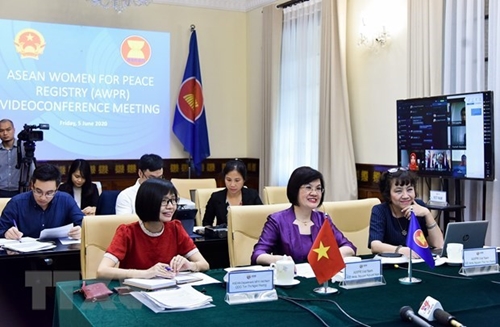The session, initiated by Vietnam, aims to affirm the ASEAN leaders’ commitment to promoting gender equality and women’s role in the building of the ASEAN Community and socio-economic development of the bloc.
It also marks the 25th anniversary of the Beijing Declaration and Platform for Action.
    |
 |
|
At a video-conference of the ASEAN Women for Peace Registry |
At the third ASEAN Ministerial Meeting on Women (AMMW), themed “Social Protection for Women and Girls: Toward the ASEAN Community Vision 2025” in Hanoi in 2018, Prime Minister Nguyen Xuan Phuc said women and girls play an important role in the ASEAN Community building, noting each of them must have equal rights in both family and society.
Since ASEAN was established in 1967, women have made significant contributions to the growth and prosperity of the member countries.
They have worked hard to improve their role and position, with the establishment of the ASEAN Community Women’s Circle in Hanoi in 2015, grouping wives and female officials of the Vietnamese Ministry of Foreign Affairs and representative offices of the ASEAN member countries in Hanoi.
Over the past five years, the group has organized a range of cultural activities and people-to-people exchanges, contributing to enhancing intra-bloc connectivity.
The ASEAN Women for Peace Registry (AWPR) was also formed in the Philippines in 2018 to promote women’s participation and contributions to the peace processes, the settlement of traditional and non-traditional security challenges emerging in the region, and the implementation of ASEAN leaders’ Joint Statement on Women, Peace, and Security in 2017.
Vietnam is one of the countries that have gained remarkable achievements in gender equality, which have contributed to spurring national socio-economic development.
To promote gender equality and increase social security for women and girls, the government has implemented and integrated relevant regional initiatives and priorities into national programs and projects.
It spends about 2.6 percent of the national gross domestic product (GDP) each year on policies and programs on social assistance, covering women and girls.
The country has made efforts in implementing the Law on Gender Equality 2006 and the UN Convention on the Elimination of All Forms of Discrimination against Women.
A national strategy on gender equality for 2011-2020 has been promulgated with the aim of raising public awareness of gender equality, narrowing gender gap, and improving women’s position.
There are more women engaging in political activities at all levels, with the rate of female parliamentarians reaching 27.1 percent, higher than the global figure of 23.4 percent and the Asian rate of 18.6 percent.
Vietnam has a National Assembly Chairwoman and three female Politburo members for the first time.
Notably, the first Vietnamese female officers have joined UN peace-keeping missions.
Vietnamese women have also proven their role in business and other spheres, with the rate of female laborers standing at 48 percent.
Still, Vietnam is continuing to perfect its relevant policies and laws, and optimize resources to ensure gender equality and women’s empowerment.
Source: VNA